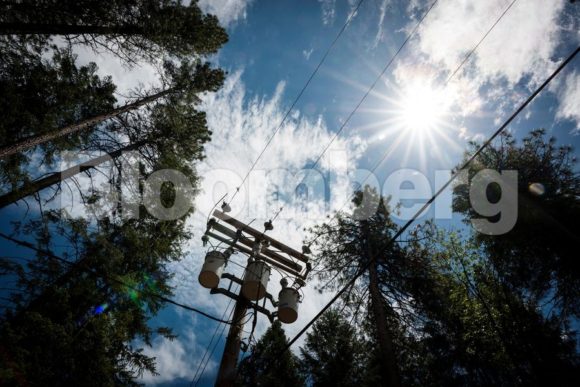California residents who were incredulous after the head of PG&E Corp. signaled a decade more of blackouts face an unnerving prospect: he may just be right.
Four mass power shutoffs in a month have disrupted life in California, forcing schools and business to shut and plunging millions of people into darkness. Wildfires the blackouts were aimed at preventing erupted nonetheless, with blazes breaking out across much of the state last week and forcing hundreds of thousands to evacuate.
While windstorms have subsided and fires are now largely under control, utilities seeking to avoid liabilities will probably continue cutting power to keep live wires from sparking wildfires when powerful winds kick up. Companies such as PG&E and Edison International can lessen the need for blackouts, but the potential solutions are costly, time consuming and aren’t guaranteed to work.
“I think there will be sections of California where this is a feature of the landscape essentially for good,” said Michael Wara, a professor at Stanford University.
Here are some the steps the state and utilities can take to lessen the need for shutoffs, and the respective challenges.
Go Underground
Sticking power lines underground is an obvious, popular method to keep them from sparking wildfires. It’s also time-consuming and extremely expensive — as much as $2.4 million per mile in the suburbs, according to a 2012 survey — although there are ways to trim the cost.
Some power lines can’t easily be buried at all. The PG&E transmission line that sparked California’s deadliest wildfire, destroying the town of Paradise, crosses steep mountain ravines, making below-ground trenches infeasible.
Make it Hard
There are other ways to harden the electric grid, and California’s utilities are pursuing these solutions. Wooden utility poles can be swapped with ones made of steel or composite materials, and power lines can be installed with a protective coating so they won’t easily spark when tree limbs hit them. But again, this can’t happen quickly or cheaply, especially for a utility like PG&E whose service territory spans 70,000 square miles (181,300 square kilometers).
The utility widely seen as doing the most to fire-proof its grid, Sempra Energy’s San Diego Gas & Electric, still resorts to shutoffs when rain hasn’t fallen for months and winds rise. PG&E Chief Executive Officer Bill Johnson last month warned state regulators it might take 10 years to dramatically reduce the need for deliberate blackouts, and politicians are still criticizing him for it.
Prune Trees
California regulators have recently forced utilities to more aggressively trim trees near their lines. But there’s only so much that can do. The Getty fire that scorched parts of Los Angeles, near some of the city’s toniest addresses, began when a branch snapped off a eucalyptus tree in high winds and flew into a power line 25 feet (8 meters) away.
Change Liability Rules
California utilities would dearly love to change “inverse condemnation,” a legal doctrine that makes them financially liable for fires sparked by their equipment, even when they followed all of the state’s safety rules. Fear of liability gives the companies a big incentive to err on the side of shutting off power whenever a wind storm looms.
But even if the state changes the way inverse condemnation works, the utilities could still be sued by fire victims claiming the companies were negligent in maintaining their equipment, said Toby Shea, an analyst for Moody’s Investors Service. Additionally, there remains the incentive of saving lives. “They are stuck between a rock and hard place,” Shea said. “It’s difficult, and it won’t get better until” power providers fully harden their infrastructure, he said.
Get Alternative Power
Starting next year, all new homes built in California will be required to have solar panels. While that won’t reduce the need for preemptive blackouts, it could help utility customers endure them. But that’s if the arrays are paired with batteries — something the state hasn’t mandated.
Standard solar systems are designed to supply power to the grid, not directly to houses. That means when the grid goes down, houses with solar panels lose power too.
Microgrids — systems that can function as their own energy islands when the larger grid goes dark — have been growing in popularity among businesses and universities. They also won’t eliminate the need for blackouts, and they cost money and take time to install.
–With assistance from Mark Chediak.
Was this article valuable?
Here are more articles you may enjoy.


 Smoke Damage from LA Wildfires Leaves Questions to Be Answered
Smoke Damage from LA Wildfires Leaves Questions to Be Answered  Family of Canadian CEO Killed in Helicopter Crash Files $35 Million Lawsuit
Family of Canadian CEO Killed in Helicopter Crash Files $35 Million Lawsuit  Deutsche Bank’s DWS Pays $27M in German Greenwashing Case
Deutsche Bank’s DWS Pays $27M in German Greenwashing Case  Bankruptcy Judge Shoots Down $10 Billion J&J Settlement
Bankruptcy Judge Shoots Down $10 Billion J&J Settlement 